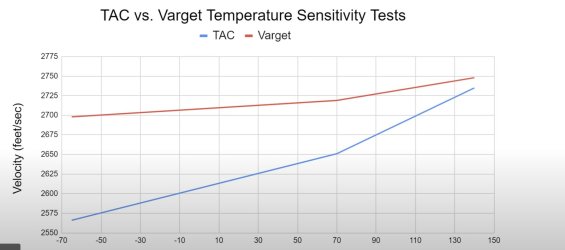Huntaddict
Well-Known Member
I took a look at some testing that was done in recent areas of temp variations. I wanted to know
Many brands claim that their powders are not temp sensitive, across certain types. Not all but most of the newer powders do carry that marketing around them. I wanted to see what NATO testing found with modern powders.
Cliff notes - in the graph they did find variations on velocities depending on powder, in this case Varget and TAC were tested. Varget is famous for being very temp stable.
Testing was conducted from -65 degrees to 140 degrees. I would venture that <1% of hunters are hunting in those conditions in the same year. Note: In "normal" hunting temps with Varget, -10 and 90 degrees Fahrenheit, the found approx a 15fps variance in velocity. Tac saw a more
Does this mean you have to change powder in your rifle? I have never been on a hunt or shoot where temps have changed that much in a day or two. Up to you.
However to me, I am zeroing my rifle at every hunt so unless I am seeing pressure signs hunting in 90+ degree temps, I am going to rezero, validate and go without ever changing my powder. Why i try to stay in the 90-94% range, to ensure I have my most accurate node without issue...at any temp.
Many brands claim that their powders are not temp sensitive, across certain types. Not all but most of the newer powders do carry that marketing around them. I wanted to see what NATO testing found with modern powders.
Cliff notes - in the graph they did find variations on velocities depending on powder, in this case Varget and TAC were tested. Varget is famous for being very temp stable.
Testing was conducted from -65 degrees to 140 degrees. I would venture that <1% of hunters are hunting in those conditions in the same year. Note: In "normal" hunting temps with Varget, -10 and 90 degrees Fahrenheit, the found approx a 15fps variance in velocity. Tac saw a more
Does this mean you have to change powder in your rifle? I have never been on a hunt or shoot where temps have changed that much in a day or two. Up to you.
However to me, I am zeroing my rifle at every hunt so unless I am seeing pressure signs hunting in 90+ degree temps, I am going to rezero, validate and go without ever changing my powder. Why i try to stay in the 90-94% range, to ensure I have my most accurate node without issue...at any temp.

